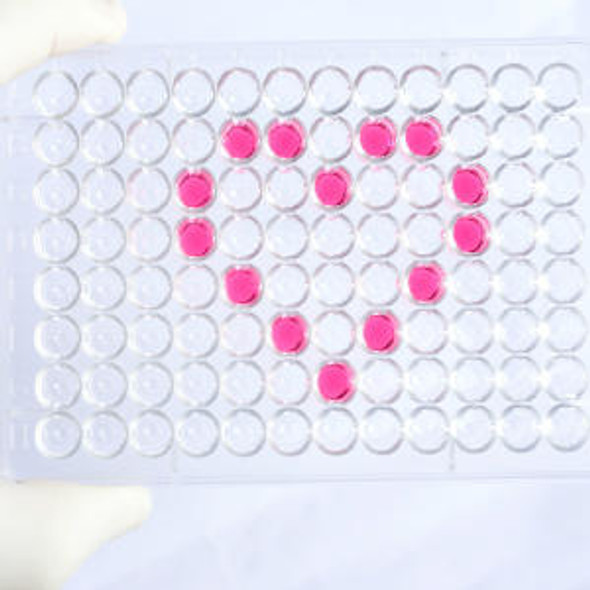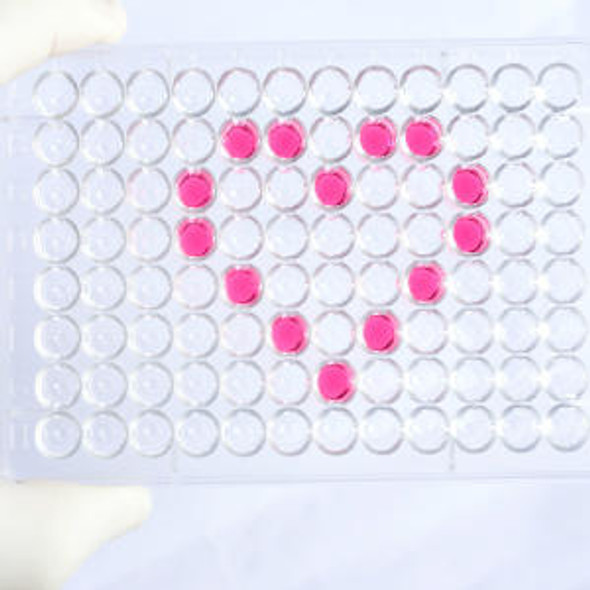Human Ankyrin-2 (ANK2) ELISA Kit
- SKU:
- HUEB1843
- Product Type:
- ELISA Kit
- Size:
- 96 Assays
- Uniprot:
- Q01484
- Range:
- 78-5000 pg/mL
- ELISA Type:
- Sandwich
- Reactivity:
- Human
Description
| Product Name: | Human Ankyrin-2 (ANK2) ELISA Kit |
| Product Code: | HUEB1843 |
| Alias: | Ankyrin-2, ANK-2, Ankyrin-B, Brain ankyrin, Non-erythroid ankyrin, ANK2 |
| Uniprot: | Q01484 |
| Reactivity: | Human |
| Range: | 78-5000 pg/mL |
| Detection Method: | Sandwich |
| Size: | 96 Assay |
| Storage: | Please see kit components below for exact storage details |
| Note: | For research use only |
| UniProt Protein Function: | ANK2: In skeletal muscle, required for proper localization of DMD and DCTN4 and for the formation and/or stability of a special subset of microtubules associated with costameres and neuromuscular junctions. Attaches integral membrane proteins to cytoskeletal elements. Also binds to cytoskeletal proteins. Required for coordinate assembly of Na/Ca exchanger, Na/K ATPase and InsP3 receptor at sarcoplasmic reticulum sites in cardiomyocytes. Required for the coordinated expression of the Na/K ATPase, Na/Ca exchanger and beta-2-spectrin (SPTBN1) in the inner segment of rod photoreceptors. Required for expression and targeting of SPTBN1 in neonatal cardiomyocytes and for the regulation of neonatal cardiomyocyte contraction rate. Defects in ANK2 are the cause of long QT syndrome type 4 (LQT4); also known as sick sinus syndrome with bradycardia. Long QT syndromes are heart disorders characterized by a prolonged QT interval on the ECG and polymorphic ventricular arrhythmias. They cause syncope and sudden death in response to exercise or emotional stress. LQT4 displays many atypical features compared to classical long QT syndromes, including pronounced sinus bradycardia, polyphasic T waves and atrial fibrillation. Cardiac repolarization defects may be not as severe as in classical LQT syndromes and prolonged QT interval on EKG is not a consistent feature. 4 isoforms of the human protein are produced by alternative splicing. |
| UniProt Protein Details: | Protein type:Adaptor/scaffold; Motility/polarity/chemotaxis Chromosomal Location of Human Ortholog: 4q25-q27 Cellular Component: neuron projection; costamere; basolateral plasma membrane; integral to plasma membrane; T-tubule; M band; cytosol; Z disc; lipid raft; postsynaptic membrane; cytoskeleton; perinuclear region of cytoplasm; apical plasma membrane; plasma membrane; intracellular; sarcolemma; A band Molecular Function:protein binding, bridging; protein binding; enzyme binding; potassium channel regulator activity; spectrin binding; structural constituent of cytoskeleton; protein kinase binding; ATPase binding Biological Process: axon guidance; protein stabilization; regulation of heart rate; T-tubule organization and biogenesis; positive regulation of potassium ion transport; regulation of protein stability; regulation of calcium ion transport; regulation of release of sequestered calcium ion into cytosol; paranodal junction assembly; cellular calcium ion homeostasis; protein localization in organelle; response to methylmercury; positive regulation of calcium ion transport; cardiac muscle contraction Disease: Cardiac Arrhythmia, Ankyrin-b-related |
| NCBI Summary: | This gene encodes a member of the ankyrin family of proteins that link the integral membrane proteins to the underlying spectrin-actin cytoskeleton. Ankyrins play key roles in activities such as cell motility, activation, proliferation, contact and the maintenance of specialized membrane domains. Most ankyrins are typically composed of three structural domains: an amino-terminal domain containing multiple ankyrin repeats; a central region with a highly conserved spectrin binding domain; and a carboxy-terminal regulatory domain which is the least conserved and subject to variation. The protein encoded by this gene is required for targeting and stability of Na/Ca exchanger 1 in cardiomyocytes. Mutations in this gene cause long QT syndrome 4 and cardiac arrhythmia syndrome. Multiple transcript variants encoding different isoforms have been described. [provided by RefSeq, Dec 2011] |
| UniProt Code: | Q01484 |
| NCBI GenInfo Identifier: | 387912917 |
| NCBI Gene ID: | 287 |
| NCBI Accession: | Q01484.4 |
| UniProt Related Accession: | Q01484 |
| Molecular Weight: | |
| NCBI Full Name: | Ankyrin-2 |
| NCBI Synonym Full Names: | ankyrin 2 |
| NCBI Official Symbol: | ANK2 |
| NCBI Official Synonym Symbols: | LQT4; ANK-2; brank-2 |
| NCBI Protein Information: | ankyrin-2 |
| UniProt Protein Name: | Ankyrin-2 |
| UniProt Synonym Protein Names: | Ankyrin-B; Brain ankyrin; Non-erythroid ankyrin |
| Protein Family: | Ankyrin |
| UniProt Gene Name: | ANK2 |
| UniProt Entry Name: | ANK2_HUMAN |
| Component | Quantity (96 Assays) | Storage |
| ELISA Microplate (Dismountable) | 8×12 strips | -20°C |
| Lyophilized Standard | 2 | -20°C |
| Sample Diluent | 20ml | -20°C |
| Assay Diluent A | 10mL | -20°C |
| Assay Diluent B | 10mL | -20°C |
| Detection Reagent A | 120µL | -20°C |
| Detection Reagent B | 120µL | -20°C |
| Wash Buffer | 30mL | 4°C |
| Substrate | 10mL | 4°C |
| Stop Solution | 10mL | 4°C |
| Plate Sealer | 5 | - |
Other materials and equipment required:
- Microplate reader with 450 nm wavelength filter
- Multichannel Pipette, Pipette, microcentrifuge tubes and disposable pipette tips
- Incubator
- Deionized or distilled water
- Absorbent paper
- Buffer resevoir
*Note: The below protocol is a sample protocol. Protocols are specific to each batch/lot. For the correct instructions please follow the protocol included in your kit.
Allow all reagents to reach room temperature (Please do not dissolve the reagents at 37°C directly). All the reagents should be mixed thoroughly by gently swirling before pipetting. Avoid foaming. Keep appropriate numbers of strips for 1 experiment and remove extra strips from microtiter plate. Removed strips should be resealed and stored at -20°C until the kits expiry date. Prepare all reagents, working standards and samples as directed in the previous sections. Please predict the concentration before assaying. If values for these are not within the range of the standard curve, users must determine the optimal sample dilutions for their experiments. We recommend running all samples in duplicate.
| Step | |
| 1. | Add Sample: Add 100µL of Standard, Blank, or Sample per well. The blank well is added with Sample diluent. Solutions are added to the bottom of micro ELISA plate well, avoid inside wall touching and foaming as possible. Mix it gently. Cover the plate with sealer we provided. Incubate for 120 minutes at 37°C. |
| 2. | Remove the liquid from each well, don't wash. Add 100µL of Detection Reagent A working solution to each well. Cover with the Plate sealer. Gently tap the plate to ensure thorough mixing. Incubate for 1 hour at 37°C. Note: if Detection Reagent A appears cloudy warm to room temperature until solution is uniform. |
| 3. | Aspirate each well and wash, repeating the process three times. Wash by filling each well with Wash Buffer (approximately 400µL) (a squirt bottle, multi-channel pipette,manifold dispenser or automated washer are needed). Complete removal of liquid at each step is essential. After the last wash, completely remove remaining Wash Buffer by aspirating or decanting. Invert the plate and pat it against thick clean absorbent paper. |
| 4. | Add 100µL of Detection Reagent B working solution to each well. Cover with the Plate sealer. Incubate for 60 minutes at 37°C. |
| 5. | Repeat the wash process for five times as conducted in step 3. |
| 6. | Add 90µL of Substrate Solution to each well. Cover with a new Plate sealer and incubate for 10-20 minutes at 37°C. Protect the plate from light. The reaction time can be shortened or extended according to the actual color change, but this should not exceed more than 30 minutes. When apparent gradient appears in standard wells, user should terminatethe reaction. |
| 7. | Add 50µL of Stop Solution to each well. If color change does not appear uniform, gently tap the plate to ensure thorough mixing. |
| 8. | Determine the optical density (OD value) of each well at once, using a micro-plate reader set to 450 nm. User should open the micro-plate reader in advance, preheat the instrument, and set the testing parameters. |
| 9. | After experiment, store all reagents according to the specified storage temperature respectively until their expiry. |
When carrying out an ELISA assay it is important to prepare your samples in order to achieve the best possible results. Below we have a list of procedures for the preparation of samples for different sample types.
| Sample Type | Protocol |
| Serum | If using serum separator tubes, allow samples to clot for 30 minutes at room temperature. Centrifuge for 10 minutes at 1,000x g. Collect the serum fraction and assay promptly or aliquot and store the samples at -80°C. Avoid multiple freeze-thaw cycles. If serum separator tubes are not being used, allow samples to clot overnight at 2-8°C. Centrifuge for 10 minutes at 1,000x g. Remove serum and assay promptly or aliquot and store the samples at -80°C. Avoid multiple freeze-thaw cycles. |
| Plasma | Collect plasma using EDTA or heparin as an anticoagulant. Centrifuge samples at 4°C for 15 mins at 1000 × g within 30 mins of collection. Collect the plasma fraction and assay promptly or aliquot and store the samples at -80°C. Avoid multiple freeze-thaw cycles. Note: Over haemolysed samples are not suitable for use with this kit. |
| Urine & Cerebrospinal Fluid | Collect the urine (mid-stream) in a sterile container, centrifuge for 20 mins at 2000-3000 rpm. Remove supernatant and assay immediately. If any precipitation is detected, repeat the centrifugation step. A similar protocol can be used for cerebrospinal fluid. |
| Cell culture supernatant | Collect the cell culture media by pipette, followed by centrifugation at 4°C for 20 mins at 1500 rpm. Collect the clear supernatant and assay immediately. |
| Cell lysates | Solubilize cells in lysis buffer and allow to sit on ice for 30 minutes. Centrifuge tubes at 14,000 x g for 5 minutes to remove insoluble material. Aliquot the supernatant into a new tube and discard the remaining whole cell extract. Quantify total protein concentration using a total protein assay. Assay immediately or aliquot and store at ≤ -20 °C. |
| Tissue homogenates | The preparation of tissue homogenates will vary depending upon tissue type. Rinse tissue with 1X PBS to remove excess blood & homogenize in 20ml of 1X PBS (including protease inhibitors) and store overnight at ≤ -20°C. Two freeze-thaw cycles are required to break the cell membranes. To further disrupt the cell membranes you can sonicate the samples. Centrifuge homogenates for 5 mins at 5000xg. Remove the supernatant and assay immediately or aliquot and store at -20°C or -80°C. |
| Tissue lysates | Rinse tissue with PBS, cut into 1-2 mm pieces, and homogenize with a tissue homogenizer in PBS. Add an equal volume of RIPA buffer containing protease inhibitors and lyse tissues at room temperature for 30 minutes with gentle agitation. Centrifuge to remove debris. Quantify total protein concentration using a total protein assay. Assay immediately or aliquot and store at ≤ -20 °C. |
| Breast Milk | Collect milk samples and centrifuge at 10,000 x g for 60 min at 4°C. Aliquot the supernatant and assay. For long term use, store samples at -80°C. Minimize freeze/thaw cycles. |









